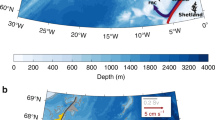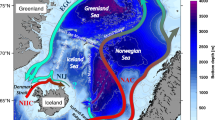Abstract
The Denmark Strait overflow water is the largest dense water plume from the Nordic seas to feed the lower limb of the Atlantic Meridional Overturning Circulation. Its primary source is commonly thought to be the East Greenland Current. However, the recent discovery of the North Icelandic Jet—a deep-reaching current that flows along the continental slope of Iceland—has called this view into question. Here we present high-resolution measurements of hydrography and velocity north of Iceland, taken during two shipboard surveys in October 2008 and August 2009. We find that the North Icelandic Jet advects overflow water into the Denmark Strait and constitutes a pathway that is distinct from the East Greenland Current. We estimate that the jet supplies about half of the total overflow transport, and infer that it is the primary source of the densest overflow water. Simulations with an ocean general circulation model suggest that the import of warm, salty water from the North Icelandic Irminger Current and water-mass transformation in the interior Iceland Sea are critical to the formation of the jet. We surmise that the timescale for the renewal of the deepest water in the meridional overturning cell, and its sensitivity to changes in climate, could be different than presently envisaged.
This is a preview of subscription content, access via your institution
Access options
Subscribe to this journal
Receive 12 print issues and online access
$259.00 per year
only $21.58 per issue
Buy this article
- Purchase on Springer Link
- Instant access to full article PDF
Prices may be subject to local taxes which are calculated during checkout




Similar content being viewed by others
References
Nansen, F. Das Bodenwasser und die Abkühlung des Meeres. Int. Rev. Gesamten Hydrobiol. Hydrogr. 5, 1–42 (1912).
Swift, J. H., Aagaard, K. & Malmberg, S-A. The contribution of the Denmark Strait overflow to the deep North Atlantic. Deep-Sea Res. 27A, 29–42 (1980).
Swift, J. H. & Aagaard, K. Seasonal transitions and water mass formation in the Iceland and Greenland seas. Deep-Sea Res. 28A, 1107–1129 (1981).
Mauritzen, C. Production of dense overflow waters feeding the North Atlantic across the Greenland–Scotland Ridge. Part 1: Evidence for a revised circulation scheme. Deep-Sea Res. I 43, 769–806 (1996).
Eldevik, T. et al. Observed sources and variability of Nordic seas overflow. Nature Geosci. 2, 406–410 (2009).
Jónsson, S. & Valdimarsson, H. A new path for the Denmark Strait overflow water from the Iceland Sea to Denmark Strait. Geophys. Res. Lett. 31, L03305 (2004).
Jónsson, S. The Circulation in the Northern Part of the Denmark Strait and its Variability. ICES Report CM-1999/L:06 (ICES, 1999).
Dickson, R. R. & Brown, J. The production of North Atlantic deep water: Sources, rates and pathways. J. Geophys. Res. 99, 12319–12341 (1994).
Girton, J. B., Sanford, T. B. & Käse, R. H. Synoptic sections of the Denmark Strait overflow. Geophys. Res. Lett. 28, 1619–1622 (2001).
Rudels, B., Fahrbach, E., Meincke, J., Budéus, G. & Eriksson, P. The East Greenland Current and its contribution to the Denmark Strait overflow. ICES J. Mar. Sci. 59, 1133–1154 (2002).
Rudels, B. et al. The interaction between waters from the Arctic Ocean and the Nordic Seas north of Fram Strait and along the East Greenland Current: Results from the Arctic Ocean-02 Oden expedition. J. Mar. Syst. 55, 1–30 (2005).
Spall, M. A. & Price, J. F. Mesoscale variability in Denmark Strait: The PV outflow hypothesis. J. Phys. Oceanogr. 28, 1598–1623 (1998).
Pickart, R. S., Torres, D. J. & Fratantoni, P. S. The East Greenland Spill Jet. J. Phys. Oceanogr. 35, 1037–1053 (2005).
Magaldi, M. G., Haine, T. W. N. & Pickart, R. S. On the nature and variability of the East Greenland Spill Jet: A case study in summer 2003. J. Phys. Oceanogr. http://dx.doi.org/10.1175/JPo-D-10-05004.1 (in the press).
Köhl, A., Käse, R. H. & Stammer, D. B. Causes of changes in the Denmark Strait overflow. J. Phys. Oceanogr. 37, 1678–1696 (2007).
Smith, P. C. Baroclinic instability in the Denmark Strait overflow. J. Phys. Oceanogr. 6, 355–371 (1976).
Ross, C. K. Temperature–salinity characteristics of the ‘overflow’ water in Denmark Strait during ‘OVERFLOW ′73’. Rapp. P.-v. Réun.-Cons. Int. Explor. Mer. 185, 111–119 (1984).
Macrander, A., Send, U., Valdimarsson, H., Jónsson, S. & Käse, R. H. Interannual changes in the overflow from the Nordic Seas into the Atlantic Ocean through Denmark Strait. Geophys. Res. Lett. 32, L06606 (2005).
Stommel, H., Bryden, H. & Mangelsdorf, P. Does some of the Mediterranean outflow come from great depth? Pure Appl. Geophys. 105, 879–889 (1973).
Kinder, T. H. & Parrilla, G. Yes, some of the Mediterranean outflow does come from great depth. J. Geophys. Res. 92, 2901–2906 (1987).
Hansen, B. & Østerhus, S. Faroe Bank Channel overflow 1995–2001. Prog. Oceanogr. 75, 817–856 (2007).
Marshall, J., Hill, C., Perelman, L. & Adcroft, A. Hydrostatic, quasi-hydrostatic, and nonhydrostatic ocean modeling. J. Geophys. Res. 102, 5733–5752 (1997).
Spall, M. A. On the role of eddies and surface forcing in the heat transport and overturning circulation in marginal seas. J. Clim. http://dx.doi.org/10.1175/2011JCLI4130.1 (2011).
Stefánsson, U. North Icelandic waters. Rit Fiskid. 3, 1–269 (1962).
Valdimarsson, H. & Malmberg, S-A. Near-surface circulation in Icelandic waters derived from satellite tracked drifters. Rit Fiskid. 16, 23–39 (1999).
Woodgate, R. A., Fahrbach, E. & Rohardt, G. Structure and transports of the East Greenland Current at 75° N from moored current meters. J. Geophys. Res. 104, 18059–18072 (1999).
Spall, M. A. Boundary currents and watermass transformation in marginal seas. J. Phys. Oceanogr. 34, 1197–1213 (2004).
Spall, M. A. Dynamics of downwelling in an eddy-resolving convective basin. J. Phys. Oceanogr. 40, 2341–2347 (2010).
Egbert, G. D., Bennett, A. F. & Foreman, M. G. G. TOPEX/Poseidon tides estimated using a global inverse model. J. Geophys. Res. 99, 24821–24852 (1994).
Egbert, G. D. & Erofeeva, S. Y. Efficient inverse modeling of barotropic ocean tides. J. Atmos. Oceanic Technol. 19, 183–204 (2002).
Thurnherr, A. M. A practical assessment of the errors associated with full-depth LADCP profiles obtained using Teledyne RDI Workhorse Acoustic Current Dopper Profilers. J. Atmos. Oceanic Technol. 27, 1215–1227 (2010).
Acknowledgements
The authors wish to thank B. Rudels and J. B. Girton for comments. Support for this work was provided by the US National Science Foundation and the Research Council of Norway. This is publication A351 from the Bjerknes Centre for Climate Research.
Author information
Authors and Affiliations
Contributions
K.V., R.S.P., H.V., S.J. and D.J.T. collected and analysed the data; M.A.S. designed and analysed the model simulations; K.V., R.S.P. and M.A.S. wrote the paper and all authors interpreted the results and clarified the implications.
Corresponding author
Ethics declarations
Competing interests
The authors declare no competing financial interests.
Supplementary information
Supplementary Information
Supplementary Information (PDF 500 kb)
Rights and permissions
About this article
Cite this article
Våge, K., Pickart, R., Spall, M. et al. Significant role of the North Icelandic Jet in the formation of Denmark Strait overflow water. Nature Geosci 4, 723–727 (2011). https://doi.org/10.1038/ngeo1234
Received:
Accepted:
Published:
Issue Date:
DOI: https://doi.org/10.1038/ngeo1234
This article is cited by
-
The distribution and diversity of eukaryotic phytoplankton in the Icelandic marine environment
Scientific Reports (2023)
-
Sea-ice retreat suggests re-organization of water mass transformation in the Nordic and Barents Seas
Nature Communications (2022)
-
Sources and upstream pathways of the densest overflow water in the Nordic Seas
Nature Communications (2020)
-
Discovery of an unrecognized pathway carrying overflow waters toward the Faroe Bank Channel
Nature Communications (2020)
-
The Iceland-Faroe Slope Jet: a conduit for dense water toward the Faroe Bank Channel overflow
Nature Communications (2020)



